
Past Summer Field School
Please check the website for updates
Questions? Contact Prof. Laura Zanotti
lzanotti@purdue.edu
We will be offering the same program summer 2018
Ethnographic Field School (Summer 2017)
Check out the CLA THiNK Magazine piece on the course
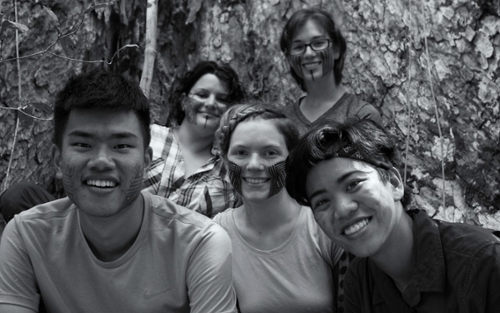 (photo by Jorge Solorzano-Filho) Eight undergraduate students participated in the Anth 418 Ethnographic Methods Summer 2016 field school program. Anth 418 is a short-term summer abroad program held in the Brazilian Amazon. Led by Associate Professor Dr. Laura Zanotti, the three-week study abroad experience is a 6-credit course where students receive training in ethnographic field methods and deepen their understanding of issues related to indigenous peoples, conservation, and development. In an unparalleled opportunity to visit Brazil and also visit with the Kayapó, an Amazonian indigenous group, students become skilled at about the rigors of qualitative research design and ethnographic research through experiential learning modules that immerse them in field-based data collection techniques and service learning programs. As a field methods course and a study abroad experience, this program also enables students to reflexively consider their own lives as they learn techniques that will sharpen their qualitative toolkit and broaden their perspectives about and experiences related to cultural diversity. We closely work with faculty and staff from the University of Uberlândia (Brazil), the Protected Forest Association (Associção Floresta Protegida-Brazil), and the Wild Foundation on this course.
(photo by Jorge Solorzano-Filho) Eight undergraduate students participated in the Anth 418 Ethnographic Methods Summer 2016 field school program. Anth 418 is a short-term summer abroad program held in the Brazilian Amazon. Led by Associate Professor Dr. Laura Zanotti, the three-week study abroad experience is a 6-credit course where students receive training in ethnographic field methods and deepen their understanding of issues related to indigenous peoples, conservation, and development. In an unparalleled opportunity to visit Brazil and also visit with the Kayapó, an Amazonian indigenous group, students become skilled at about the rigors of qualitative research design and ethnographic research through experiential learning modules that immerse them in field-based data collection techniques and service learning programs. As a field methods course and a study abroad experience, this program also enables students to reflexively consider their own lives as they learn techniques that will sharpen their qualitative toolkit and broaden their perspectives about and experiences related to cultural diversity. We closely work with faculty and staff from the University of Uberlândia (Brazil), the Protected Forest Association (Associção Floresta Protegida-Brazil), and the Wild Foundation on this course.
Students begin their abroad experience in the Amazonian city of Belem. By visiting archaeological and navigation museums, research centers, zoo-botanical gardens, and food markets, students gain a broad understanding of the complex political and economic landscapes that fuel the Brazilian Amazon today. From Belem, we travel through the agro-industrial countryside of Pará state to reach Maraba and then Tucuma, small towns at the edge of the Kayapó territories, where they interact with NGOs promoting conservation and social well-being. In Tucuma, the group meets conservation biologists and cultural activists before they head to an ecological research station and a Kayapó village for two weeks. Throughout the course, students are trained in methods and cover the following topics: ethical considerations in the field, researcher positionality, participant observation, the art of writing field notes, interviewing, participatory mapping, photography, collaborative mapping and other visual methods. In parallel, students also learn about and investigate indigenous rights, conservation, and development in the region. The 2018 Anth 418 course also will feature a service-learning component. In partnership with the community of Aukre and the Protected Forest Assocation, the group will work with the village of Aukre to complete a spoken dictionary of Kayapó, Portuguese, and English.
As a field methods course and a study abroad experience, this program enabled students to reflexively consider their own lives as they learn techniques that will sharpen their qualitative toolkit and broaden their perspectives about cultural diversity.
Student testimonies from the course
- “My study abroad experience in Brazil was singlehandedly the best experience of my life. This program is one of the most unique experiences offered at Purdue University, and it has increased my self-reliance and enhanced and helped define my academic interests. As a student interested in international conservation and non-profit management, this field experience will be an essential part of being accepted into graduate school.”
- “I'd have to say that this opportunity allowed me to grow as an individual and become more confident within my anthropological future and overall studies. I've also become more eager and aggressive towards accomplishing my general goals, and have noticed a complete change in my work ethic and levels of motivation.”
- “This experience was a dream come true for me and gave me some really valuable hands on experience that I already have started to use. Without this trip I probably would have switched majors to something that would, as my mom puts it, "give me a stable future." I believe this trip gave me the tools in order to succeed in Anthropology!”
Ethnographic Field School (Summer 2013)
Eight students- seven undergraduates and one graduate participated in the Anth 418 Ethnographic Methods Summer 2013 field school program. Anth 418 is a short-term summer abroad program held in the Brazilian Amazon. Led by Assistant Professor Dr. Laura Zanotti, the three-week study abroad experience is a 6-credit course where students receive training in ethnographic field methods and deepen their understanding of issues related to indigenous peoples, conservation, and development. This course offers students an unparalleled opportunity to visit Brazil and also visit with the Kayapó, an Amazonian indigenous group.
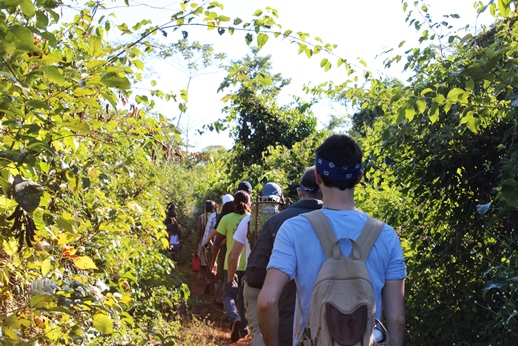
Students began their abroad experience in the Amazonian city of Belem. By visiting archaeological and navigation museums, zoo-botanical gardens, and food markets, students gained an understanding of the complex political and economic landscapes that fuel the Brazilian Amazon today. From Belem, we traveled through the agro-industrial countryside of Pará state to reach Tucuma, a small frontier town at the edge of the Kayapó territories. In Tucuma, the group met with conservation biologists and cultural activists in the region before we headed to an ecological research station and a village for two weeks. Remarkably, the students visited the village during a ceremonial event and were invited to participate in the ceremony all the while keeping in step with their abroad coursework. Throughout, students were trained in ethnographic methods and cover the following topics: ethical considerations in the field, researcher positionality, participant observation, the art of writing fieldnotes, and interviewing techniques.
As a field methods course and a study abroad experience, this program enabled students to reflexively consider their own lives as they learn techniques that will sharpen their qualitative toolkit and broaden their perspectives about cultural diversity.
Student testimonies from the 2013 course
- “My study abroad experience in Brazil was singlehandedly the best experience of my life. This program is one of the most unique experiences offered at Purdue University, and it has increased my self-reliance and enhanced and helped define my academic interests. As a student interested in international conservation and non-profit management, this field experience will be an essential part of being accepted into graduate school.”
- “I'd have to say that this opportunity allowed me to grow as an individual and become more confident within my anthropological future and overall studies. I've also become more eager and aggressive towards accomplishing my general goals, and have noticed a complete change in my work ethic and levels of motivation.”
- “Ever since I saw the mummy exhibit at the children's museum when I wasabout eight I have always wanted to grow up to be an Anthropologist. This experience was a dream come true for me and gave me some really valuable hands on experience that I already have started to use. With out this trip I probably would have switched majors to something that would, as my mom puts it, "give me a stable future." I believe this trip gave me the tools in order to succeed in Anthropology!”
Archaeological Field School (Summer 2005)
Ten students - nine undergraduate and one graduate - participated in the 2005 Archaeological field school. This eight-week field school program introduced students to archaeological theory and method, including in-depth training in historic settlement analysis, surveying and mapping, subsurface sampling, laboratory processing, and artifact analysis. Upon successful completion of the course, students were qualified to work in a variety of archaeological research arenas, including cultural resource management.
The Hovde Residence in Mulberry was the site of this year's field research. The village is situated halfway between Lafayette and Frankfort. Although peripheral to these larger urban centers, Mulberry was well-connected via transportation routes such as the Jackson Highway and the Pennsylvania Central Railroad. The Rothenbergers (1853-1884) and Steckels (1884-1904) were among the first to live in the Hovde House. Both were prominent families in the village during the second half of the nineteenth century. Their patriarchs were 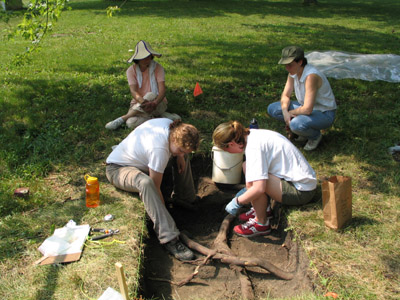 industrious farmers and successful businessmen. In both cases, the sale of the home was preceded by the death of the head of the household. This project specifically seeks to understand how the landscape of this residential landscape was originally constructed as well as changed over time.
industrious farmers and successful businessmen. In both cases, the sale of the home was preceded by the death of the head of the household. This project specifically seeks to understand how the landscape of this residential landscape was originally constructed as well as changed over time.
During the field investigations, we had a number of visitors to the site, including three groups who participated in the excavation. We co-hosted the Project Archaeology workshop with the Indiana State Museum in which nine teachers learned how to incorporate archaeology into their lesson plans. These activities that the teachers do with their students back in their classrooms fulfill state academic standards in science, mathematics, social studies, English/ Language Arts, and visual arts. One of the Project Archaeology workshop participants, Linda Glunt from Clinton Prairie School, returned the next week with 15 of her fourth graders and their parents to join in the excavation. Fourteen Science Bound campers also spent a day with us in the field.
Laboratory processing and analysis of the data continues through the efforts of a number of students taking independent study. We plan to present the results of the field school at the Annual Symposium of Ohio Valley Urban and Historical Archaeology in the spring and complete the technical report before the start of Maymester 2006.
Archaeological Field School (Summer 2004)
The excavation of the Wea View Schoolhouse (No. 8) in Wabash Township, Tippecanoe County, Indiana was undertaken as part of the annual archaeological field school at Purdue University. The project incorporated all three of the University's priorities - Learning (student training), Engagement (public involvement), and Discovery (research).
The excavation of the Wea View Schoolhouse (No. 8) in Wabash Township, Tippecanoe County, Indiana was undertaken as part of the annual archaeological field school at Purdue University. The project incorporated all three of the University's priorities - Learning (student training), Engagement (public involvement), and Discovery (research).
The excavation of the Wea View Schoolhouse (No. 8) in Wabash Township, Tippecanoe County, Indiana was undertaken as part of the annual archaeological field school at Purdue University. The project incorporated all three of the University's priorities - Learning (student training), Engagement (public involvement), and Discovery (research).
Schoolhouses during the nineteenth century were more than places of education. They were also the center of social, dramatic, political, and religious activities in their communities. In one-room schools all 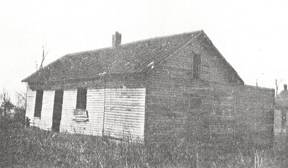 over the nation, ministers met their flocks, politicians caucused with the faithful, families gathered at Christmas parties and hoe-downs, the Grange held its baked bean suppers, Lyceum lecturers spoke, itinerants introduced the wonders of the lantern-slide and the crank-up phonograph, and neighbors gathered for spelling bees. Furthermore, as one of the few social institutions which rural people encountered daily, the common school both reflected and shaped a sense of community. Consequently, the material records of schoolhouses must be examined and interpreted with this scale of human interaction in mind.
over the nation, ministers met their flocks, politicians caucused with the faithful, families gathered at Christmas parties and hoe-downs, the Grange held its baked bean suppers, Lyceum lecturers spoke, itinerants introduced the wonders of the lantern-slide and the crank-up phonograph, and neighbors gathered for spelling bees. Furthermore, as one of the few social institutions which rural people encountered daily, the common school both reflected and shaped a sense of community. Consequently, the material records of schoolhouses must be examined and interpreted with this scale of human interaction in mind.
The Wea View School once stood on a parcel of land currently owned by the Purdue Research Foundation (a private not-for-profit organization). The first atlas on which the schoolhouse appears is the 1866 Titus atlas. Brainard Hooker, a former superintendent of schools, used this schoolhouse - known as Wea View - to illustrate the architectural style of schoolhouses constructed during the 1860s (Figure 1). So the school appears to have been built sometime between 1860 and 1866 and closed in 1916.
In1852, the Indiana State Legislature passed a general school law. However, a variety of things - including the law being challenged as unconstitutional and the Civil War - precluded the firm establishment of an organized school system in the county before 1865 (after the Civil War had ended). Furthermore, by the turn of the twentieth century, the number of small one-room or common schools was declining as the school corporation began to consolidate the educational system in the county. The Wea View School was one of the first to be opened and among the last to be closed. Therefore, its history spans the entire period of one-room schools in Tippecanoe County.
Preliminary results of shovel testing conducted during the Fall of 2003 indicated that a buried-A horizon about 5 cm thick remained intact at the base of 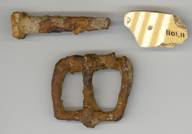 the plow zone. Artifact densities were light to moderate and included architectural debris (window glass, nails), domestic objects (amethyst bottle glass, ironstone, yellowware), and personal items (buckle) (Figure 2). Coal, charcoal, brick, and mortar were also observed. Although no features were encountered during shovel testing, it was anticipated that privies, fence lines, and other discrete features associated with its 60 years of operation remain in situ below the plow zone.
the plow zone. Artifact densities were light to moderate and included architectural debris (window glass, nails), domestic objects (amethyst bottle glass, ironstone, yellowware), and personal items (buckle) (Figure 2). Coal, charcoal, brick, and mortar were also observed. Although no features were encountered during shovel testing, it was anticipated that privies, fence lines, and other discrete features associated with its 60 years of operation remain in situ below the plow zone.
Summer 2004 field investigation included geophysical survey using a Fluxgate Gradiometer and hand-excavated units (Figure 3). The results of the remote sensing guided the placement of 1 x 1 m test units (Figure 4). We excavated 57 units during the course of the project, exposing the schoolhouses foundation (Figure 5), a fence row, privies, and other features.
Numerous visitors came to the site during the excavation. Members of the community stopped by to share their reminiscences of the schoolhouse with field school participants. School teachers joined in the excavation as part of "Project Archaeology,?? a three-day seminar co-sponsored with the Indiana State Museum. GERI campers from the College of Education also participated in the excavation as did a group of Science Bound Campers from Indianapolis. A local Boy Scout Pack (348) earned their Archaeology Badge by working with field school students in both the field and the lab.
Laboratory processing and analysis of the data recovered will continue throughout the next year (2004-2005), involving graduate and undergraduate students. Results of this research will be disseminated through presentations for Archaeology Month as well as via conference papers, state-required technical reports, and peer reviewed journal articles.